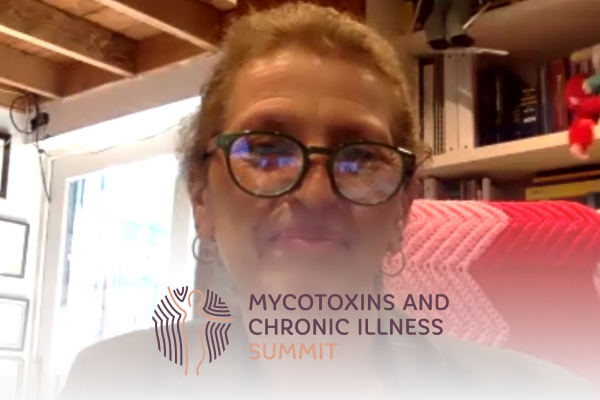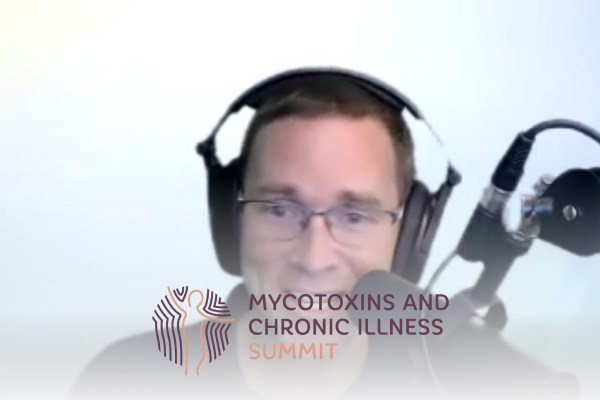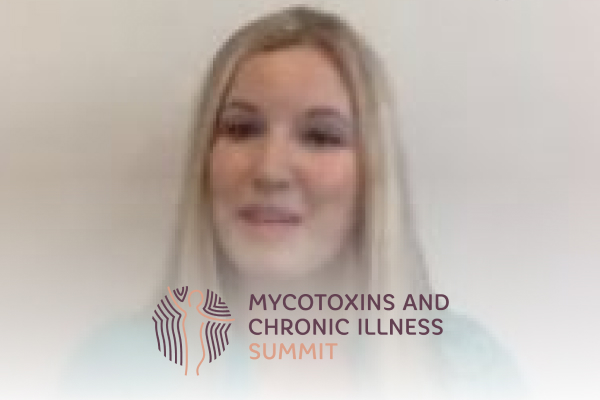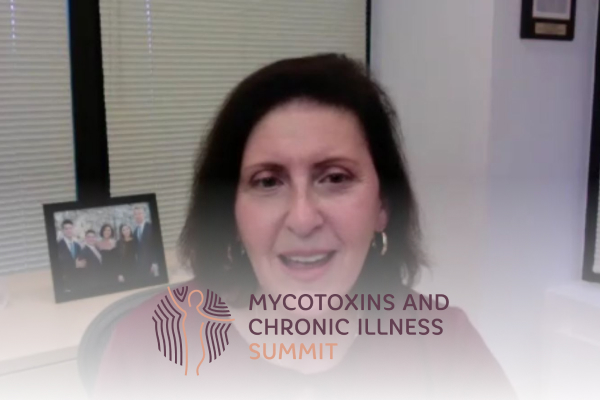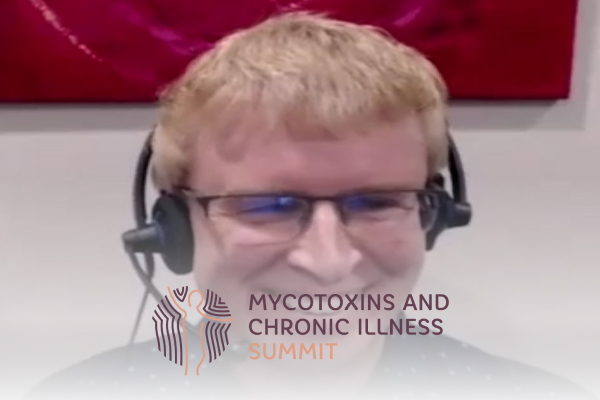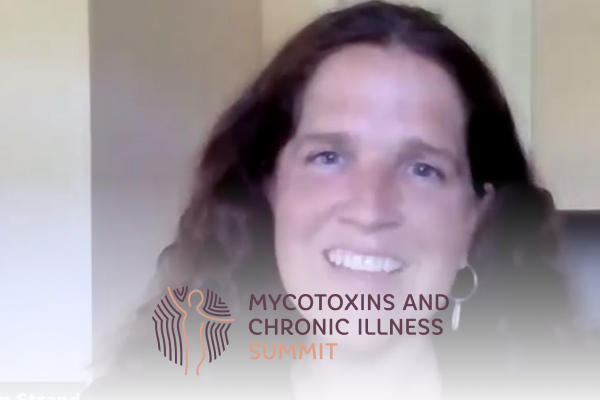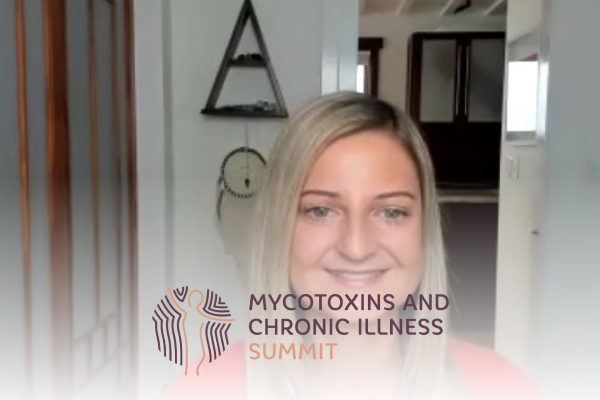Join the discussion below

Nafysa Parpia, ND has an independent practice at Gordon Medical associates, specializing in the treatment of Lyme disease and other complex chronic illnesses such as autoimmunity, mold toxicity, fibromyalgia, environmental toxicity and gastrointestinal disorders. Her patients with chronic Lyme Disease are typically those who either do not do well with antibiotics, or prefer... Read More
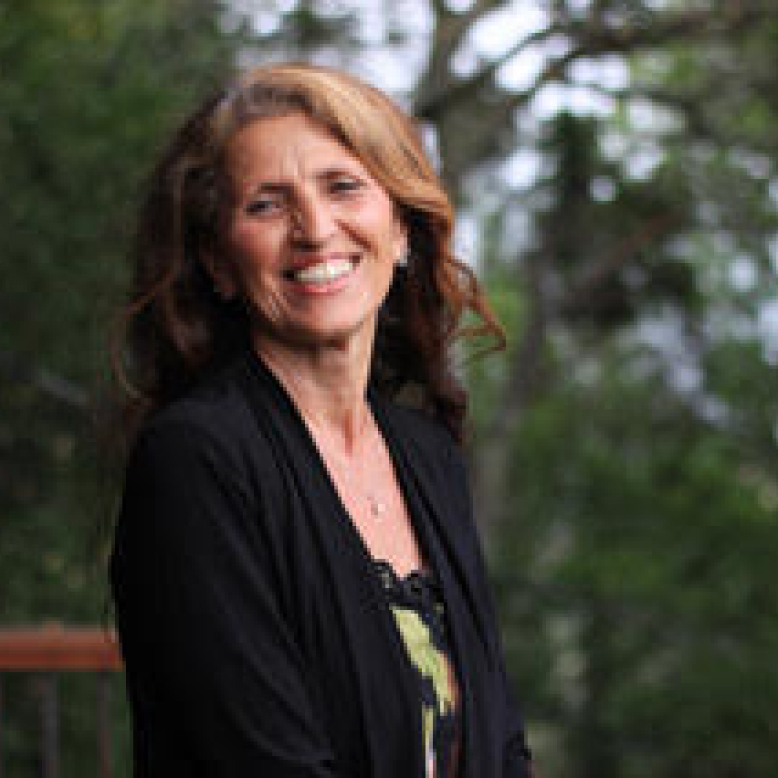
Michelle Perro, MD, DHom, is a veteran pediatrician with four decades of experience in acute and integrative pediatric medicine. Nearly twenty years ago, Dr. Perro transformed her clinical practice to include pesticide and health advocacy. She has both directed and worked as attending physician from New York’s Metropolitan Hospital to... Read More
- Acute & integrated medicine
- Mycotoxins different in children than in adults
- Chronic inflammatory syndrome
Nafysa Parpia, N.D.
Welcome to this episode of the Mycotoxin and Chronic Illness Summit. I’m very excited today to have Michelle Perro, MD, DHOM, MD, DHOM. She’s a veteran pediatrician with nearly four decades of experience in acute and integrative medicine. Dr. Perro has co-authored the highly-acclaimed book, “What’s Making Our Children Sick?” and is executive director of a nonprofit, scientific-based website, www.gmoscience.org. She has authored many publications and has a new column with the journal, the “Townsend Letter”. Stay tuned for her upcoming website for parents, drmichelleperro.com. Welcome Dr. Perro. It’s so great to have you here today.
Michelle Perro, MD, DHOM
Nafysa, thank you. Please, Michelle .
Nafysa Parpia, N.D.
Thank you, Michelle. So tell us about how mycotoxin illness is different in children than in adults.
Michelle Perro, MD, DHOM
Yes, and I focused on children for the past four decades. I have treated adults, so I do have a perspective. And I think there are several ways it differs. Number one is that they’re not as sick as long, obviously, right? A three-year-old will not be the same as a 40-year-old. Number two is they have an underlying different immunology. They have more NK cells, they have more innate immunity, and so it differs. They’re not just mini adults. So they have that difference.
They have diminished detoxification pathways. Some are not as fully developed like their PON1, paraoxonase 1, or they’re cytochrome P450. their microbiome, which is the primary line of detoxification, may not be as so robust because the baby’s microbiome is still evolving till about three. Three years old is when it’s set. So the four points that I usually cover what differs kids from adults in terms of mycotoxins is they’re not as encumbered, or have as many comorbidities. So for example, an adult might have hypertension, high blood pressure, type-1 diabetes, et cetera. Kids, hopefully, are a bit cleaner, so they’re not as encumbered. So despite them having not as robust detoxification system, hopefully they don’t have the same number of toxins and toxicants.
Nafysa Parpia, N.D.
I find that very interesting. I’m thinking right now of my patients with Lyme disease and how there was research done by Bob Miller, right, about people with chronic Lyme, they have more snips in their genes of detoxification than people who don’t suffer from chronic Lyme. The same people being bit by a tick, but some have snips and some don’t, snips in their genes of detoxification. And it seems, very directly, that my patients, when I look at their snips in their genes of detoxification, I am seeing a higher environmental toxicant load in those people. So higher metals, higher glyphosate, higher pesticides, other chemicals. And so when you were talking about children and their genes and the higher load of mycotoxins, I find that really interesting. What do you think about other toxin loads in children, Michelle?
Michelle Perro, MD, DHOM
Well, it’s interesting you say that because… And we could get into this and kids who develop CIRS, which is chronic inflammatory response syndrome, they also have CIRS, of that group, and it’s about 12% of kids, we think, from an article I read from 2017, have CIRS. And we can go into that further in a minute when we talk about the kind of diseases they get and illness from mycotoxins. But of that group, 25% do have genetic snips, mostly in their HLA-DR. And we also found that to be true in kids who suffer from chronic pesticide toxicity from organophosphates.
For example, from the work from a group out of UC Berkeley, the CHAMACOS study, which has been going on in Salinas Valley in California for the past, almost, 20 years. Those kids had a snips in their PON1 enzyme. And for those kids who had snips in PON1, they weren’t able to detox from organophosphate pesticides, which have just gotten banned, chlorpyrifos. Hallelujah, that took a couple of decades, a major neurotoxin in children. Right, so when you have a toxic soup and you have environmental toxicants and you have mycotoxins and you have chronic infection, Lyme, co-infections, and you have EMFs, et cetera, that toxic soup is what makes kids, and it increases their allostatic load and they’re unable to clear it. And for some of them, it just pushes them over the edge.
Nafysa Parpia, N.D.
Right, it makes total sense. Now, I’m tying it back to what you said about their microbiome. If their microbiome isn’t yet fully developed, I’m sure children are having a difficult time detoxifying as well, because as you said, that’s the biggest organ of detoxification. Tell us more about that.
Michelle Perro, MD, DHOM
Oh, my God. I’ve been focusing the past five years on microbiome. I am like all about the bugs brain and bugs, gut and bugs, lungs and bugs, every kind of micro-pathway. And so I think one of the biggest reasons why mycotoxic illness is so prevalent now, and why I didn’t see it 34 years ago, was I missing it, really? It’s pretty profound, is because, I’ll say one word, and that’s glyphosate. And glyphosate, main ingredient in Roundup. Everybody knows that herbicide now. And I won’t talk about glyphosate specifically, but in the context of mycotoxin illness, is glyphosate, because of herbicide-tolerant crops, which have exploded in the past 20 years since they were introduced in 1996. The amount of glyphosate children are exposed to has hit the roof exponentially in glyphosate-based herbicides.
Glyphosate kills off the soil microbiota and has an abundance of fungi that have taken off. So in soils that have been sprayed with glyphosate-based herbicides, they have a high load of fungi. They have a high load of mycotoxins, and that is in our food. So like, for example, cereals, grains have incredible amounts of aflatoxin, different mycotoxins. Grapes, various ferments that kids like to eat. And not even ferments, just basic things like… I know some kids who just, all they eat is breakfast cereal, and cereals are notorious for mycotoxins. So in my opinion, glyphosate is one of the main reasons for the explosion in mycotoxin illness, is the use of this ubiquitous herbicide. And of course, GMOs. And you don’t eat them alone. Your GMO crop, you eat it with the pesticide.
Nafysa Parpia, N.D.
And I’ll say, I don’t treat children very much, Michelle, very few, mostly adults. But when I’m looking at my adults’ labs, I’m looking at their mycotoxin values, I’m looking at their glyphosate and sure enough, I’m gonna see both of those high, side by side, and I’m detoxing both in adults. So I’m sure it’s different, the process of detoxification, in children than adults, and I’m gonna have you tell us about that in a minute. But first, tell us about the clinical symptoms of mycotoxin illness in kids.
Michelle Perro, MD, DHOM
So the way I like to think of mycotoxin illness, and it wasn’t like I was born knowing this, by the way, Nafysa, like, “Oh yeah, I’ve always known mycotoxin illness.” Oh, no, no. Initially, I didn’t become aware of it until maybe the past, maybe, 10 years, and I’ve been practicing 40. And it’s just shocking to me, because there were reports in the literature from 1993 about babies who suffered from mycotoxin illness from water-damaged buildings. So it’s been in the pediatric literature, traditional literature, tons of reports, but yet it didn’t translate into clinical practice. And that, to me, is another horror. So the way I like to break down mycotoxic illness, I like to think of it is allergic-based in type-1 immunity and allergy symptoms.
I like to think of it in terms of mold and infection, and then the effects on the mycotoxins themselves. So I kind of break it up into these three categories. So if we look at just the issue with allergy, and let’s say… So mold can produce spores, spores are airborne, and those airborne spores can trigger allergies, environmental allergies, and asthma. And asthma is endemic right now. It’s reported anywhere from 1 in 5 to 1 in 10 kids now has asthma, depending on their ethnicity. 1 in 8 white kids, 1 in 6 African-American children, and Latinos are all over the map. Because Latinos, you can be Puerto Rican or you can be Mexican, and you’re grouped in one batch. Puerto Rican children, for example, 20% of them have asthma, very humid climate in Puerto Rico.
Whereas in Mexico, hot and dry, it’s about 1 in 9, and Mexican-American children, especially those who live in a hotter, drier climate. Environmental allergies, those are usually type-1 hypersensitivity and also food allergies. So type-1 food allergies are 1 in 13 kids now, but that doesn’t even include food intolerances, which in the patients I’ve seen might be anywhere from 40 to 90% of kids I see have IgG, IgA antibodies to foods. So in terms of infection, yes, you can have mold-based infection like candida. Now candida’s a yeast, which is a kind of a fungus. Mold is a kind of a fungus. There are some candidal species that can be mold or yeast. And so in many of our patients, chronic tick-borne in patients, patients with heavy metals, and autism, they have secondary issues with candida.
And so, then you would have to treat the pathologic infection, whether it’s a yeast or mold or an overlap. And then, the worst is the mycotoxins. And they, in my opinion, in children, cause the most damage. They can cross the placenta. You can get intrauterine microtoxicity. They’re 50 times smaller than spores. They’re nanoparticles. They’re lipophilic. And there are, I believe… So there are 200,000 kinds of fungi, and fungi is a kingdom. Of that 200,000, there’s 100,000 types of mold. Of those mold, only 80 are pathologic to humans. And because we’ve now recreated a new environment because of pesticides, we have now created a sea of chronic toxicity from the mycotoxins. We didn’t have it before, Nafysa. So that’s the kind of way I like to break it out. Did I answer your question? I’m kind of all over the map with that.
Nafysa Parpia, N.D.
You sure did. So this is the way I look at it in adults too, with those three. So the allergic response, the immune response, the mycotoxins and also looking mast cell, I’m sure you do too, mass cell activation syndrome. I think the children, they have more asthma than adults, for sure, as a symptom. You talk about the toxic soup, right, that our environment is now, and that we were meant to live side by side with these bugs. There’s been mold since before we’ve been around, and ticks, and viruses, and parasites. And all of a sudden people are showing up younger and younger with illnesses that just were not there before.
Mycotoxin illness, that didn’t exist 10 years ago, maybe 10 years ago, but certainly not 15 years ago. And I fully agree with you. It has to do with the toxins, which are… And there’s research showing this, which are changing our immunological response. So on one hand, they’re making us hyper-sensitive. And on the other hand, they’re not allowing us to mount an appropriate immune response to kill off infections. And so now, we’re seeing this in younger and younger people. We have some work to do, don’t we?
Michelle Perro, MD, DHOM
Nafysa, your point is spot on. And I do believe, you heard me talking about glyphosate, but I think one of the reasons why, that children now are so predisposed to mycotoxin illness, is because they’re not the same. They’re suffering from two conditions, which I see ubiquitously in kids. And one is intestinal permeability with subsequent brain permeability, and we could talk about how mycotoxins affect that, and dysbiosis. So if I have any kid with any chronic disease, which over about, I used to say 53 to 54%, it’s probably 60% of children now have a chronic disease. Since I even wrote that book, which is a couple of years ago.
Nafysa Parpia, N.D.
Wow, that’s a marked increase.
Michelle Perro, MD, DHOM
Since we wrote the book, autism scaled up. All these diseases are scaling up. And so it’s just blown my mind. So kids now have an imbalanced Th1/Th2 right at the intestinal epithelial level. They should have a more robust, innate immunity, Th1. But now, because of leaky gut, they’re up-regulating Th2 and making more antibody production, and they have chronic inflammation. Now, in order to deal with mycotoxin illness, it just so happens you need… It’s an adaptive immune response so you need more antibody, more cytokines. But remember, and I think about this even now during COVID, you want a robust Th1 and innate immunity, ’cause those people seem to have less of a problem with COVID and more NK cells.
So it’s this balance. It’s the balance, even the balance of the microbial community you were talking about. We live in balance with Th1/Th2 and adaptive and innate immune function in kids. And it’s why I think kids who are not having a problem with COVID have more of a robust, Th1, innate immunity and more NK cells. I don’t think it’s a mystery. Why are the kids doing well with COVID? I think that’s one of the reasons. Now, I don’t wanna be overly simplistic here or reductionistic, but I think that has a lot to do with it.
And so when you then impose this mycotoxin illness on top of kids who are chronically upregulated, that’s where I think we get into trouble, because then we get into CIRS, the chronic inflammatory response syndrome and where kids start getting into this, almost like, as Bob Naviaux talks about, cell danger response gets triggered and they get into an inflammatory hamster wheel and not in a reparative kind of situation. And that’s where I go, “Uh, oh.” If kids don’t get into that, you can quickly resolve their mycotoxin illness. When they get into that CIRS, and according to this one study I read from Dr. McMahon in 2017, he’s saying 12% of kids now have this CIRS, which I find mind-blowing. I’m like, “Really?”
Nafysa Parpia, N.D.
That’s a high percentage.
Michelle Perro, MD, DHOM
Yeah, I mean, it’s crazy. So that’s where I wanna jump in quickly. I don’t want that CIRS cycle starting to go on. They’re harder to reverse as you know.
Nafysa Parpia, N.D.
Exactly. As they get older, they’re gonna get more stuck in a chronic inflammatory response that’s just meant to be transient. When that response is transient, that’s a sign of health, of good health. But then, they get stuck in constant inflammation. And I’m so happy that you’re there catching it for them when they’re young before they become adults. I wanna hear more about the symptoms in children. So asthma, what else are you seeing, Michelle?
Michelle Perro, MD, DHOM
Sure, so a lot of symptoms in kids are dependent on how long they’ve had it and their age. So for example, in toddlers, toddlers get mycotoxin illness too, it’s often gut-related. Tummy aches and headaches. So I think of the symptoms in terms of age-based, and then I think of it as gut, neuro, and systemic. So I always take in the age and whether they’re a verbal child or non-verbal child, et cetera. I try to put into three big categories. That’s where most of the symptoms live, not all. So gut-related, it’s tummy aches. It’s often change in appetite, often decreased appetite, and the gut-brain axis, headaches So that would be tummy. Under systemic, they get a lot of fatigue.
They complain of being tired a lot. It’s fatigue, ’cause I think their immune system’s upregulated. So a lot of fatigue. And then, under neuro, that’s where my radar goes way up. Kids who have an acute change in their neurologic function or new onset of OCD, night terrors, mood swings, massive mood swings. All of a sudden they’re flipping all over in their emotions or focus issues, like 12% of kids now have ADHD. Is it due to a mycotoxin? Possibly. I had a case like that. And so when I see all that, I think mycotoxin, I’m thinking brain inflammation, I’m thinking low MSH, because mycotoxins drive down alpha-MSH. And gut leaky brain and increased inflammagens in the brain and in the gut. I kind of like to break it down. Most of their illnesses tend to fall in there. So it’s the gut, the systemic, and then the neurologic stuff.
There are other things too. Some kids have superficial things like some skin findings, some kids have insomnia. I mean, it could be… Just like adults, it’s kind of all over the map, but that’s where it tends to focus. But if I hear, like I heard of a 12-year-old going… He was home, this was recent, home during COVID, just went back to school. While he was out of school, they redid the school. They did new building, new this, new that. Goes back in the school, and he gets massive changes in his behavior. His pediatrician said, “Oh yeah, it’s stress from COVID.” Right? No, it was a sick building and it was mycotoxin exposure. And I could tell you how I figured it out. It wasn’t like I was a genius. I just did a lab test and I, oh, and I examined the patient. I know that’s kind of crazy. Kids don’t get touched anymore. So when you have that change in mood, change in mental status, change in focus, just don’t think this is a mental illness. Think it’s a toxic illness. So like adults, it can be all over the map, but those tend to be the main areas.
Nafysa Parpia, N.D.
And so will you see sudden changes, typically, in children or is it sort of a slow, insidious change in symptoms, like behavior, neurological?
Michelle Perro, MD, DHOM
It can be both. Some kids can go on to have chronic tummy aches, just don’t feel good. They’re tired all the time. It’s kind of low-grade and chronic, and I think they’re being exposed chronically, let’s say, for example, in their homes. But some kids, they probably have chronic inflammation going on from whatever etiology, and then they’re placed in a toxic environment, and then they have a sudden crash. So you can see both. The chronics are more commonly what I see. Just chronic, don’t feel good, always tired. They’re they’re just like cranky, dark circles under their eyes, maybe chronic congestion, maybe they have chronic sinusitis. Hopefully, not MARCoNS. I see that too, or the rapid onset. So you can see both. And your radar has to be both open for acute, subacute, acute on chronic, and chronic.
Nafysa Parpia, N.D.
So actually, a couple of thoughts I’m having all at once in my mind. One of them is family members, parents, siblings, do you see this in many family members or in siblings, or do you often see just one person and that’s the kid in the family?
Michelle Perro, MD, DHOM
And that’s what’s so maddening for families. Only one kid will be affected, and that parents will say, “You’re just a complainer. Your siblings are fine. Nothing wrong with them.” But that kid may have the HLA-DR snip and the others don’t. So that is a way more common scenario than you’d imagine. When you have a whole family move into a new home and all five family members are sick from the sick building, and I had that from a new family in Petaluma. There was black mold under their new home, and all five of them immediately got sick, really sick. That was easy. They all got sick. So it had to be an exposure. But if it was just one family member, that kid often gets labeled as a complainer, or just cranky, or difficult. I’ve heard all of it, off to the psychiatrist. So those I find are more challenging.
Nafysa Parpia, N.D.
That happens in adults, too. One family member in the household, and then they get isolated. They get told their crazy, or this is all in their head, or they’re lazy. And that’s just not true.
Michelle Perro, MD, DHOM
It’s not true, especially now, isolating kids further than they’re already isolated.
Nafysa Parpia, N.D.
Exactly. So what tools do you use to diagnose and treat mycotoxin illness?
Michelle Perro, MD, DHOM
This can get tricky, Nafysa, and I’ll tell you why. So the way I like to think about diagnostic tools, I like to think about direct and indirect. And there’s direct testing and there’s indirect testing. The beauty of mycotoxin testing in kids directly is that it’s a urine test. Ye-ha, no blood. Blood work in a little four-year-old who’s vasoconstrictive and you wanna get that list of labs that we often do in adults, like the CIRS panel, and I need 15 red-top tubes. I don’t think so. Let’s say, there are three labs that I basically use looking at mycotoxins in urine, and I’ve used real-time and I’ve had a problem with that, me, personally.
Some people love real-time. That’s great. I’ve looked at GPL, Great Plains Lab, and GPL does mass spec and they also do chromatography, or Vibrant looks at 31 mycotoxins all through mass spec. So I think I like the mass spec testing best, just so you know. And I think real-time is ELISA. So you have to know what tools the lab is using. So when you send him home for a urine test, make sure if it’s a baby, someone in a diaper, you give them a few urine bags. ‘Cause as soon as you put that urine bag on the kid, they pee around it. I can tell you that right away, and you don’t wanna be squeezing out the diaper to get the urine for the sample, right.
And then, you can cut a little hole in the diaper if it’s a disposable and put the U-bag through and collect the urine, and it doesn’t have to be a clean catch. So that is what I like to do. And I like to see how many mycotoxins they have. And I did a kid recently. I treated him and all his mycotoxins came down. It was like, “Oh, oh, this works.” And he felt better. Then, there’s indirect testing, which are labs. And those are indirect measurements of mycotoxic illness. And so remember how much blood can you get from a kid, and do you really wanna do more than one draw? Now, if it’s a big teenager, sure, go for it. If it’s a three-year-old, you don’t have endless amounts of blood you can draw off, and you might be able to only get two tubes on one stick. So in the ideal world, let’s say, this is my ideal world. I like baseline labs at some point, treating that kid. And I want a CBC, I want a 7 ferritin, I want RBC, magnesium, and zinc, I want a vitamin D level, and MTHFR, as my baseline. The metabolic panel, if I can just get that, they’re my base labs.
If I can get more than that or some number of those and a little bit more, and this is all insurance-based, I try to do as much as insurance, because those mycotoxin direct testing, all cost out-of-pocket, anywhere from 300 to $800, I believe. There’s a wide range, it’s expensive. And if you’re testing three kids in your family, you’re already hit 900 bucks, right. We gotta be careful here. And then, so indirect blood work I like for kids. If I need a C4a, a complement, which goes up almost all… I’ve only seen it up in mold illness. It’s an inflammatory marker, a complement pathway. If I get a C3a also, and those go out to Denver Jewish, I believe, where those are sent out. If I can get an MSH level, antidiuretic hormone level… This is my ideal world. This is my ideal. If I can get, let’s see if there’s anything else that I must have, besides that MSH, VIP, perhaps.
But if I could just get a few of those, and if I had to pick one, it’d be complement C4a. Because, why, number one is paid-for insurance. Number two, with mold toxin illness, it’s off the charts elevated. And as you treat them and they get better, it comes down. And I love to see that number come down. It should be around 2,300. And with a mycotoxin illness, you’ll see 18,000. And kids can really be reactive by the way. They’ll shoot up. I had a kid once with 23,000. They get better. And then, the tick-borne infection is often not as high. And with tick-borne infection. they don’t hit the 18,000 mycotoxin, in my experience, 6,000, 8,000 are when I see those really high numbers. And then, I’ve heard some MDs who treat mycotoxin talk about the difference between C3a and C4a with Lyme and TBI and mycotoxin illness. So labs are my adjunct. I try to use a clinical diagnosis. I like to get the mycotoxin levels. And if, at least I can get, at least maybe MSH, ADH, and C4a, I’m really a really happy practitioner.
Nafysa Parpia, N.D.
Great, well, thank you for that . Tell us about your favorite tools for dealing with mycotoxin illness in kids.
Michelle Perro, MD, DHOM
Okay, so when you see these kids with mycotoxin illness, often, they’ve been sick for a long time, and they’re not acute in general. We’re not dealing with an acute situation like they’re having severe asthma. It’s usually chronic, ongoing, and low grade. The headaches, the tummy aches, sleep, fatigue, and they might be sick for six months, two years, et cetera. So I have phases of treatment that I go through. So I, like every other practitioner, start with the gut. So first thing I do is I, if I can’t get past reducing the toxic exposure, I say we’re going nowhere. If they can’t remediate the home and/or school, I had one kid change schools. Molds are common in schools in moist areas.
Oh, my God. And sometimes the kid has to be pulled out of that school as hard as that is, or the home, and you have to get the home and the school tested. Not everybody has black mold growing in their bathroom and that’s easy. But sometimes, you pull up the kids baseboards where they’re sleeping and there’s like black mold everywhere, or in the garage and they’re sleeping on top of the garage. I’ve had all those scenarios. And so I spend a lot of time on that. If they can’t move out of that, why? If you can’t take the kid out of the toxic environment, why I’m about to spend all that kid’s money? Then, I spend a lot of time on diet. I don’t need to talk about organic. I mean, people probably say, “Oh no, please, no more organic.” Yes, organic.
Oh yeah, here she goes. But I talk about a low-mold diet, taking out cheese, grains, ferments, mushrooms, and all those foods. And I spend a lot of time on phase one and phase two. You haven’t heard me talk about treatment yet. Just get them out. Some kids, when you take them out of the moldy home, if they’re healthy or the moldy school, they feel better. There are some kids… Not everybody’s so chronically ill. I had one kid, West Marin, here in California, and went to a new school, chronic headache. And they had put a new carpet in the school. And I did research, and I thought it was the glue, environmental toxicant giving chronic headache. He came out the school, his headache went away. That was 10 years ago.. Years later, I found out it was mold.
Nafysa Parpia, N.D.
How’d you find out years later?
Michelle Perro, MD, DHOM
I had another kid. And then I went and said, “Wait a minute.” So sometimes kids have gotten better, and I was thinking it was the glue and the intoxicant was a solvent exposure, but it was a mycotoxin exposure. But you did the same treatment. You removed them from the toxic environment. And so that kid with the school… And then, I went back. You have these cases where you go back and go, “Uh-oh, wait a minute.” It’s like, “Whoa!” Oh, light bulb! So that was phase two. So phase one, phase two. Phase three is I treat intestinal permeability and dysbiosis, and I heal the leaky gut. We all have our tools, and I won’t go into how to heal leaky gut. Everyone knows how to do that.
But I would like to say rebounds of the microbiome, there are certain probiotics that seem to help better with mycotoxins, certain strains of organisms, and those are lactobacilli strains. There is plantarum, casei rhamnosus, all seem to help offset mycotoxin illness. So I give a probiotic that’s really robust with those lactobacilli strains, strains matter, bifido, and get them rebalanced. Okay, so then I bring in nutraceuticals and nutrients to restore wherever they’re deficient. Most of the kids I see are deficient in minerals, because they’re on a glyphosate-enriched diet, and glyphosate binds minerals. It’s a chelator. Their mags are low, magnesium, their zincs are low, their B12s are low. And what are we doing, folks? So you try to balance their nutrition. They’re starting to feel better, ’cause you already removed the toxic load. You’re starting to heal their leaky gut. You heal their leaky gut, that heals their leaky brain.
You rebalance their microbiota which is helping them detox. Done that. Okay, then I start detoxification. Detox, detox, detox. And I like homeopathy. So I either do liver, spleen, kidney, and that’s one line of remedies I use, or I do liver, spleen, kidney, brain, joint, and matrix from another company. So I’ll do either one series of detox remedies or another, depending on the age of the kid and their symptoms. So I’ve done my detox. Now, then I start going after the mold, and I have a three-pronged therapy I use. I like nutraceuticals, homeopathics, and botanicals. So I think it’s important that every practitioner get into their groove, whatever company you like, whether you like herbals, whether you like homeopathy, whether you like energy medicine, whatever your groove is, you have to get really comfortable in your groove.
So I will start with, I use DesBio a lot, and they have something called OmniCleanse Powder. But essentially what it is, and the reason why I like it so much, it’s a multivitamin with a lot of antioxidants with glutathione, because their glutathione goes in the trash, but it’s not enough. And it’s a powder, everything in one. So if you’re a treating a kid on the spectrum with mycotoxin illness, something you need to look for, those kids are often picky eaters. You can’t be giving them a hundred supplement that tastes yucky. That OmniCleanse Powder tastes really good. So I do that, then I have a detox from DesBio I like which has things like NAC in it and calcium d-glucarate. And it’s a capsule, and I mix that in with their drink. I open the capsule, and then I give them a liposomal bio C and biocidin, liposomal glutathione, and something called MYC:Combo, which is a homeopathic for mycotoxins. And that’s it. And then, I do that. Once I do the detox, I start treating them. In about four weeks, they feel a hell of a lot better.
Nafysa Parpia, N.D.
That’s amazing.
Michelle Perro, MD, DHOM
That’s it. It’s not hard.
Nafysa Parpia, N.D.
With kids, right, when you’re doing it right?
Michelle Perro, MD, DHOM
And they get better. And it’s amazing, especially… But again, I don’t jump into detox until I get other things working.
Nafysa Parpia, N.D.
Me neither.
Michelle Perro, MD, DHOM
That’s my approach. Everyone’s got their own approach. I don’t start detoxing you until I make sure your gut is as good as I can get it.
Nafysa Parpia, N.D.
Right, I call that pretox, so getting them set up for detoxification.
Michelle Perro, MD, DHOM
I love pretox. It’s not a pretense pretox. I love it. So that’s how I do it. And then, I follow them, and then I’ll get, if parents can afford it, I will get another mycotoxin level test, like I did with this one kid. And this one was from Vibrant labs. Everything came down, especially his aflatoxin. This one kid I recently treated with super high aflatoxin, carcinogen on peanuts, et cetera. I don’t know where he got it from. He doesn’t even eat peanuts, but their everywhere, and it came way down.
Nafysa Parpia, N.D.
Beautiful.
Michelle Perro, MD, DHOM
And he’s feeling better, and his brain is functioning. ‘Cause all of a sudden the kids’ brains will start to kick in.
Nafysa Parpia, N.D.
I love that.
Michelle Perro, MD, DHOM
That’s kind of my approach, how I do it.
Nafysa Parpia, N.D.
That’s great. Well, thank you, Michelle. Is there anything else that you wanna share with our listeners today about children and mycotoxin illness?
Michelle Perro, MD, DHOM
Yeah, the other thing that I would remind folks is that kids who have complex chronic disease, and most of those kids tend to have tick-borne infections, who are missed for years, and they also have mycotoxins, often when you treat the other infections, like tick-borne illness, they’ll get better. ‘Cause you’re doing, again, leaky gut, dysbiosis. You’re giving them, let’s say, an herbal antibiotic, which might help them offset their mold as well. You’re giving them a, perhaps, nice statin, or if you use some grapefruit seed products for their candida. So they’re still gonna get better, Nafysa, even though, perhaps in the beginning, when I was treating a tick-borne illness years ago, before I got into mold toxin, they were getting better and I was probably getting their mold toxin better too, but I didn’t know it at the time.
And I have become much more cognizant of treating mycotoxin as the years have gone by. In the beginning, when I was first starting, I wasn’t as cognizant of it. I’m way more aware of it now than I used to be. So I tell people, as kids get better, oftentimes, and you remove the toxic load, their allostatic load, and you improve their detox pathways, especially phase one, phase two, phase three detox, They’re gonna just feel better. And with kids, unlike adults, when you kind of put everything back in balance, they’ll often get better. When you’re give their bodies the tools to heal, their systems aren’t so undone and their inherent ability to heal is still robust, they will often heal themselves. Everyone hears two words. They hear Lyme and mold, and they freak out like they have an incurable disease. And I say, “It’s hard. I don’t wanna pretend like this is easy. It’s not easy.”
Nafysa Parpia, N.D.
No, but it’s doable.
Michelle Perro, MD, DHOM
Very doable.
Nafysa Parpia, N.D.
It’s very doable.
Michelle Perro, MD, DHOM
It’s doable, but there’s nothing easy about it, and it took me a long time to get here and a lot of trial by fire and things like that. But it’s treatable. It takes time. And with kids and adults, it’s never a straight shoot. It’s sideways. It’s left, it’s right. And it’s like just be patient and keep working at it. But what I also say is when, periodically, when a case stalls, which they do, and all of a sudden it’s like, “What happened?” This kid was getting so much better, now he’s not. I have parents send me photographs of their pantry and their refrigerator.
Nafysa Parpia, N.D.
Uh-ha, and what do you find? .
Michelle Perro, MD, DHOM
Well, I find treats that are not organic. I find cooking oils like canola that’s not organic and it’s GMO. I find that the whole family did take-out pizza last Friday, full of glyphosate, wheat, legumes, oats, full, full of Roundup. And I’m not asking for perfection, but if you have a really sick kid, you have to follow it. Just let’s get them over the hump. Because if you can just get them over that hump, oftentimes, then they’ll start to cruise. And it’s not always gonna be this way. And unfortunately, treating a kid in a family, the whole family needs to be on the same diet as the kid. It’s not fair to have little Susie on a kale salad and everybody else is doing Mike’s Pizza takeout. It doesn’t work.
Nafysa Parpia, N.D.
It sure doesn’t. I’m glad you bring up this point.
Michelle Perro, MD, DHOM
So as I treat the family… And sorry, the family has to all go with the lowest common denominator, sorry. And they’ll all feel better.
Nafysa Parpia, N.D.
The family starts to feel better, right? They’re all grateful at the end of the day. And it’s a change in lifestyle.
Michelle Perro, MD, DHOM
They all feel better and they are grateful. And that’s happened to me so many times. And my favorite story is one dad who had chronic renal failure, and I just changed the kids diet to organic and the dad’s renal failure resolved from 20% to 80% kidney function when we took Roundup out of his diet.
Nafysa Parpia, N.D.
Beautiful.
Michelle Perro, MD, DHOM
So there are these little gifts you get along the way. So those are my clinical pearls. I’m trying to think if I have any others. No, I think those are my main pearls.
Nafysa Parpia, N.D.
Thank you. And tell us again, the name of your book. I wanna make sure that the audience knows the name of your book and how to find it, ’cause it’s an important one. Go for it.
Michelle Perro, MD, DHOM
Yes, thank you. So I wrote this wonderful book with Dr. Vincanne Adams a couple of years ago, and I still find it relevant, “What’s Making Our Children Sick?” And it’s about industrial food and the effect on our children’s health based on my patients. And Dr. Adams was a naysayer when we first started. She said, “There’s no way, Michelle, what you’re saying is true.” And by the 20th interview she did with my patients, she did like an, “Oh, my God” moment, hail Mary. And the other thing I’m working on, because I’m so alarmed at the lack of integrative childcare for parents who don’t have access to people who care for kids, that I’m starting a weekly Zoom. I hope it will be up July 1. That’s my hope, drmichelleperro.com. And it’s a membership for parents. It might be too simplistic for our listeners. I’m going over the nuts and bolts. It’ll be topic-focused and parents can ask me questions, live, in action, on Zoom weekly. And I’ll be starting that. And my first topic, I was gonna do immune function, but it may be how to prevent vaccine reactions. I can’t even believe I’m said the V word, but I’m getting a lot of emails and questions about that right now.
Nafysa Parpia, N.D.
that’s basic. Not at all, because guess what? Most parents are new at it, right? They’ve never been a parent before, unless they’re a couple of kids in. But no matter how much finesse they have with an organic diet and wellness in general, until somebody has a sick kid, they suddenly have a new path. So Michelle, I’m so happy you’re there to help these people on this path. They need it.
Michelle Perro, MD, DHOM
They do need it. And it’s not easy. And parents need a PhD now to navigate the supermarket. It’s not easy. And I’m not saying this is easy and to care for a chronically-ill child, oh my God, that is a tough road.
Nafysa Parpia, N.D.
It is. It’s really tough.
Michelle Perro, MD, DHOM
It’s really hard. Listen, I have a lot of respect for families who are managing. I have a family who has three sons all with autism. I mean, there are some families who are so burdened with challenges from their children. I don’t know how they do it. And I hold a lot of empathy for families and try to offer things that they can actually do. I mean, to get these sophisticated protocols, like I’m telling practitioners now, no, I’m not having families navigate these protocols. But if they have a kid with mold toxin illness, they need to work with someone who knows what they’re doing to get their kid through it. You can’t do mold toxin illness on your own. Well, there’s a few people who can, but most humans cannot. It’s challenging. So they should work with a practitioner.
Nafysa Parpia, N.D.
So to all the families out there who might be suffering, there are practitioners, doctors, who are here for you. We’re here to help you, and we always send you lots of love and healing thoughts.
Michelle Perro, MD, DHOM
Yes, and what I didn’t mention in my program is there were a lot of other healing modalities that I will bring in, like hands-on therapies, osteopathic treatments, ozone therapies. It gets more involved and I just gave you the outline. I’m a big fan of ozone, for example, and that heals a lot of mycotoxin illness. Or I’m a big fan of craniosacral osteopathy and other hands-on techniques, acupuncture or acupressure. So I’m not negating all these other therapies and modalities that we use. I just, for the sake of brevity, didn’t bring them all in. And of course, it’s individualized for each kid. So some kids respond really well to acupressure, some don’t. So then, this becomes the art of the practice and individualized medicine.
Nafysa Parpia, N.D.
Yes, I really enjoyed this conversation with you, Michelle. I think it brings a lot of hope to families who maybe feel like their isn’t any, but there is. So I think that’s just a really important message for everybody. Thank you for the work you do.
Michelle Perro, MD, DHOM
Thank you, Nafysa. I am just delighted to be here and share my experience with you, with listeners, on what it took for us to get here. And I will do these talks as we need to and reach as many people as we need to because healing and health are possible and why shouldn’t we all have healing and health? So this is our gift to our communities. And boy, if I can share it, I’m happy to do so.
Nafysa Parpia, N.D.
Thank you so much. I couldn’t agree more.
Michelle Perro, MD, DHOM
My pleasure.
Downloads

